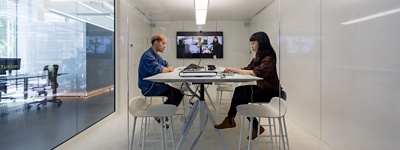Designing the Future of Work With Experimentation, Not Anticipation
HR leaders must embrace an agile mindset and flexible work-design framework—or risk being stuck in reaction mode.

HR leaders must embrace an agile mindset and flexible work-design framework—or risk being stuck in reaction mode.

Hybrid work schedules. Skills-centric talent management. A culture of inclusion capable of spanning remote teams and global time zones. There’s no question that the challenges human resources (HR) professionals might lose sleep over look very different than they did a decade—or even three years—ago.
“It’s very clear that the events of the last few years have, essentially, put a blowtorch on work and the work relationship. It’s melting; it’s refreezing; it’s happening all the time,” said John Boudreau, senior research scientist and professor emeritus at the University of Southern California’s Marshall School of Business, speaking at the “Office of HR: The Power to Adapt Through the Evolution of Work” keynote at Workday Rising.
In times of tumult and rapid change, Boudreau said that there’s often a knee-jerk reaction among company leaders to roll out new policies that speak to the specifics of the exact moment. But, he added, “I’m firmly convinced that a policy is the wrong answer.”
Avoiding the usual policy-update reflex doesn’t mean ceding control to chaos. “What it means is inviting—and continuing to invite—your workers, your managers, and your leaders to experiment,” said Boudreau. He explained that this way, your policy becomes, in effect: “We don’t know what the future is, but we know that we need to engage together to evolve as the future unfolds.” It’s a process Boudreau likes to call “agile work design through experiments.”
To fully appreciate the power of agile experimentation, Boudreau asked the audience to consider the early era of software design. Developers would roll out a new product, and if customers complained, it was largely seen as a chance to double down on convincing them how wrong they were and how great the product was, as is. But slowly, companies realized those customer complaints had value and folding that feedback into an ongoing cycle of updates sparked new and better ideas—and, ultimately, better products.
The same is true for work, said Boudreau. “When one of your workers complains that, ‘This policy doesn’t work for me,’ that is not a signal that the manager should convince them they’re wrong,” he said. “It’s a signal that there ought to be a process to listen. It’s a cue to ask: What can we learn here?” Likewise, he said, work design that’s underpinned by collaboration and rigorous experimentation creates fertile ground for fresh ideas and novel approaches that might otherwise never be considered.
Work design that’s underpinned by collaboration and rigorous experimentation creates fertile ground for fresh ideas and novel approaches that might otherwise never be considered.
“Realize that work is going to be perpetually obsolete and perpetually upgraded, just like your phone, just like your automobile, just like other products. So let’s collaborate around responding to change, rather than following a plan, ” he said. “It sounds heretical in a way, but there was a time when trusting customers to help design products seemed like a heretical idea as well.”
To foster a productive environment of experimentation—rather than a chaotic one where everyone does whatever they want, whenever they want, in the name of trying something new—Boudreau recommends CHROs adopt an agile framework.
A popular methodology among IT professionals, agile framework can be applied to any field or function. The goal isn’t a fixed endpoint but rather ongoing iteration, supported by a cycle of distinct phases. In software development, agile tools are often organized around phases of testing, discovering, design, and development, he said. HR leaders may instead want to parse work-design experiments into: interact, collaborate, and respond.
What’s most important, Boudreau stressed, is that the approach prioritizes individuals and interactions over comprehensive processes and specific tools. “If we apply that to work, it means worker and manager collaboration over approved policy exceptions,” he said. “It means focusing on workers and teams more than job descriptions. Let the job description melt. Don’t get stuck in that description.”
That insight proved instrumental at Air Liquide, said Yee-Lin Chong, head of HR digital solutions, center of excellence at Air Liquide (Asia-Pacific region), who also spoke at the CHRO keynote. Earlier this year, the global gas technologies service provider completed an HR transformation initiative to unify employee services for its workforce of 11,000 employees across 80 countries—a first in the company’s 120-year history, Chong said. The project blueprint was firmed up just as the pandemic hit. But massive disruption didn’t derail momentum, Chong explained, in part because the HR team was laser focused on gathering insights and ongoing feedback, rather than merely executing a prescriptive plan.
“We had to engage intensively within HR domains, but even more so cross-functionally—across IT, finance, and lines of business,” said Chong. “We had to fight against a tendency to always think in our respective silos and instead look outside, to our customers, our employers, our managers, and see what matters to them.”
Though Air Liquide is now live with Workday, Chong stressed that the company’s transformation journey will always be ongoing. “Like any scientific experiment, measuring our results and the employee feedback loop are crucial for us to be able to see what’s working and what needs improvement,” she said. “But now that we have a foundational platform in place, I think it puts us in a better position for future initiatives.”
For instance, when the company set out to replace its antiquated physical time clocks with a mobile solution, its earlier Workday implementation meant workers were already comfortable with and accustomed to accessing work information on their mobile devices. Chong channeled the same spirit of collaboration and experimentation for the new effort, assembling a diverse cross-functional team, rolling out a targeted pilot, and rigorously tracking feedback and employee sentiment—before leveraging the lessons learned for future improvements.
There’s no question that the challenges HR professionals might lose sleep over look very different than they did a decade—or even three years—ago.
Boudreau, commenting on the Air Liquide pilot, said, “This isn’t simply implementing a system and then hoping it works, or implementing a system and letting everyone play with it. It was approached as an experiment: creating a cross-functional hub, bringing in the data, bringing employee experience to the fore, and learning throughout.”
Boudreau believes that HR is uniquely positioned to take the lead on implementing such agile frameworks, to design work that can dynamically adapt as business needs shift and new challenges emerge.
“Make work and organization design the object of the same constant experimentation that you apply to your products and your software,” he urged the audience of HR leaders. “Just like a product development group steps up to be the hub for product design experiments, what if CHROs stepped [up] and said: ‘We will be the hub for work experimentation and design’? What if CHROs said to their teams: ‘Let’s start with admitting that we don’t know the future of work, and then let’s experiment rigorously’?”
More Reading

Discover how skills-based hiring unlocks access to a wider range of skilled individuals, helping organizations build more agile and effective workforces. Read about the strategies and benefits of this transition, supported by data showing 86% of leaders are ready for change.

The rise of skills-based hiring has turned recruitment on its head. But why has it proved so revolutionary compared to traditional hiring, and how can your business ensure it stays ahead of the curve?

As midsize businesses grow, the cracks in siloed systems start to show—making enterprise resource planning (ERP) essential. Identify the best ERP for midsize companies with our helpful guide.